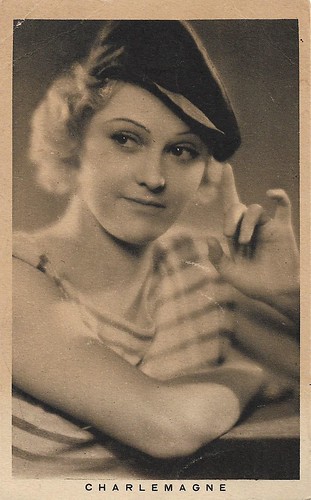Raimu and Marie Glory were the stars of the French film Charlemagne (Pierre Colombier, 1933). This Pathé Natan production was based on the comic play 'The Admirable Crichton' by J.M. Barrie.

French postcard by Rasiogravure A. Breger Frères, Paris for Victor-Hugo Théâtre Pathé Natan. Photo: Raimu in Charlemagne (Pierre Colombier, 1933).

French postcard by Rasiogravure A. Breger Frères, Paris for Victor-Hugo Théâtre Pathé Natan. Photo: Raimu in Charlemagne (Pierre Colombier, 1933).
Charlemagne is a 1933 French comedy-drama directed by Pierre Colombier and starring Raimu and Marie Glory. Other cast members are Léon Bélières, Jean Dax, Gaston Jacquet and Lucien Baroux.
A group of seven upper-class passengers of a ship is saved from drowning by a stoker and brought to a desert island. The stoker then proposes to the sailor Charlemagne (Raimu) to become the king of the peninsula.
Yves Mirande wrote the screenplay, based on the 1902 comic stage play 'The Admirable Crichton' by Scottish novelist and playwright J. M. Barrie, best known as the creator of 'Peter Pan'.
Barrie took the title from the sobriquet of a fellow Scot, the polymath James Crichton, a 16th-century genius and athlete. The plot may derive from 'Robinson's Eiland', an 1896 German play by Ludwig Fulda. In this satire, a group of Berlin officials (including a capitalist, a professor and a journalist) is shipwrecked on an island, where a secretary, Arnold, becomes the natural leader of the group.
The play was filmed several times, including a silent British version, The Admirable Crichton (1918) directed by G. B. Samuelson and starring Basil Gill. In 1919 it was filmed by Cecil B. DeMille as Male and Female starring Gloria Swanson.
An early Hollywood sound version, the screwball musical We're Not Dressing (Norman Taurog, 1934), is about a beautiful yacht owner (Carole Lombard) who becomes stranded on an island with her socialite friends, a wacky husband-and-wife research team (George Burns and Gracie Allen), and a singing sailor (Bing Crosby).
A popular sound version is the British-American production The Admirable Crichton (Lewis Gilbert, 1957) starring Kenneth More. Lina Wertmüller directed an Italian version, Travolti da un insolito destino nell'azzurro mare d'agosto/Swept Away (1974) starring Giancarlo Giannini and Mariangela Melato. Less successful was the remake, Swept Away (Guy Ritchie, 2002) with Madonna and Adriano Giannini, the son of Giancarlo Giannini.

French postcard by Rasiogravure A. Breger Frères, Paris for Victor-Hugo Théâtre Pathé Natan. Photo: Marie Glory in Charlemagne (Pierre Colombier, 1933). Publicity for the release of the film at the Pathé Natan cinema in Lyon as of 22 December 1933.

French postcard by Rasiogravure A. Breger Frères, Paris for Victor-Hugo Théâtre Pathé Natan. Photo: Raimu and Marie Glory in Charlemagne (Pierre Colombier, 1933).

French postcard by Rasiogravure A. Breger Frères, Paris for Victor-Hugo Théâtre Pathé Natan. Photo: Raimu in Charlemagne (Pierre Colombier, 1933).
Sources: Wikipedia and IMDb.

French postcard by Rasiogravure A. Breger Frères, Paris for Victor-Hugo Théâtre Pathé Natan. Photo: Raimu in Charlemagne (Pierre Colombier, 1933).

French postcard by Rasiogravure A. Breger Frères, Paris for Victor-Hugo Théâtre Pathé Natan. Photo: Raimu in Charlemagne (Pierre Colombier, 1933).
Swept away and not dressing
Charlemagne is a 1933 French comedy-drama directed by Pierre Colombier and starring Raimu and Marie Glory. Other cast members are Léon Bélières, Jean Dax, Gaston Jacquet and Lucien Baroux.
A group of seven upper-class passengers of a ship is saved from drowning by a stoker and brought to a desert island. The stoker then proposes to the sailor Charlemagne (Raimu) to become the king of the peninsula.
Yves Mirande wrote the screenplay, based on the 1902 comic stage play 'The Admirable Crichton' by Scottish novelist and playwright J. M. Barrie, best known as the creator of 'Peter Pan'.
Barrie took the title from the sobriquet of a fellow Scot, the polymath James Crichton, a 16th-century genius and athlete. The plot may derive from 'Robinson's Eiland', an 1896 German play by Ludwig Fulda. In this satire, a group of Berlin officials (including a capitalist, a professor and a journalist) is shipwrecked on an island, where a secretary, Arnold, becomes the natural leader of the group.
The play was filmed several times, including a silent British version, The Admirable Crichton (1918) directed by G. B. Samuelson and starring Basil Gill. In 1919 it was filmed by Cecil B. DeMille as Male and Female starring Gloria Swanson.
An early Hollywood sound version, the screwball musical We're Not Dressing (Norman Taurog, 1934), is about a beautiful yacht owner (Carole Lombard) who becomes stranded on an island with her socialite friends, a wacky husband-and-wife research team (George Burns and Gracie Allen), and a singing sailor (Bing Crosby).
A popular sound version is the British-American production The Admirable Crichton (Lewis Gilbert, 1957) starring Kenneth More. Lina Wertmüller directed an Italian version, Travolti da un insolito destino nell'azzurro mare d'agosto/Swept Away (1974) starring Giancarlo Giannini and Mariangela Melato. Less successful was the remake, Swept Away (Guy Ritchie, 2002) with Madonna and Adriano Giannini, the son of Giancarlo Giannini.

French postcard by Rasiogravure A. Breger Frères, Paris for Victor-Hugo Théâtre Pathé Natan. Photo: Marie Glory in Charlemagne (Pierre Colombier, 1933). Publicity for the release of the film at the Pathé Natan cinema in Lyon as of 22 December 1933.

French postcard by Rasiogravure A. Breger Frères, Paris for Victor-Hugo Théâtre Pathé Natan. Photo: Raimu and Marie Glory in Charlemagne (Pierre Colombier, 1933).

French postcard by Rasiogravure A. Breger Frères, Paris for Victor-Hugo Théâtre Pathé Natan. Photo: Raimu in Charlemagne (Pierre Colombier, 1933).
Sources: Wikipedia and IMDb.
No comments:
Post a Comment